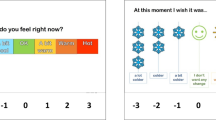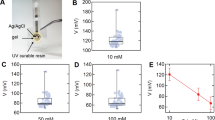Abstract
It has been previously demonstrated that the individual variation in whole-body sweat rate is described by differences in each participant’s heat balance status. It was hypothesized that the individual variation in local sweat rate of the forehead (LSRhead) and forearm (LSRarm) would be similarly described using a whole-body heat balance approach, specifically the ratio of evaporation required for heat balance relative to the maximum evaporation possible (i.e. E req:E max). Twelve males cycled at 60% \( \dot{V}{\text{O}}_{{ 2 {\text{max}}}} \) for 60 min at 24.9 ± 0.5°C, 31 ± 14% relative humidity. Rectal (T re) and aural canal (T au) temperatures as well as mean skin temperature (\( \bar{T}_{\text{sk}} \)), metabolic energy expenditure (M) and rate of external work (W) were measured throughout. In addition, whole-body sweat rate at steady state (WBSRss) was estimated using the change in body mass over the last 15 min of exercise, with LSRhead and LSRarm estimated using technical absorbent patches applied between the 50th and 55th minute. WBSRss significantly correlated with M–W (r = 0.66, P = 0.021), E req (r = 0.69, P = 0.013) and E req:E max (r = 0.87, P < 0.001); LSRhead was significantly correlated with E req:E max (r = 0.82, P = 0.001), but not M–W (r = 0.31, P = 0.328) or E req (r = 0.38, P = 0.227); and LSRarm significantly correlated with E req (r = 0.62, P = 0.031) and E req:E max (r = 0.78, P = 0.003) but not M–W (r = 0.56, P = 0.059). None of WBSRss, LSRhead or LSRarm significantly correlated with any variations in T re, T au or \( \bar{T}_{\text{b}} \) (i.e. 0.8T re + 0.2\( \bar{T}_{\text{sk}} \)). Secondary analyses also demonstrated that both LSRhead (r = 0.79, P = 0.002) and LSRarm (r = 0.89, P < 0.001) correlated with WBSRss. In conclusion, the individual variation in WBSRss, LSRhead and LSRarm is described by the ratio of E req relative to E max.




Similar content being viewed by others
References
Alber-Wallerstrom B, Holmer I (1985) Efficiency of sweat evaporation in unacclimatized man working in a hot humid environment. Eur J Appl Physiol Occup Physiol 54:480–487
ASHRAE (1989) Physiological principles, comfort and health. Fundamentals Handbook, Atlanta
Candas V, Libert JP, Vogt JJ (1979a) Human skin wettedness and evaporative efficiency of sweating. J Appl Physiol 46:522–528
Candas V, Libert JP, Vogt JJ (1979b) Influence of air velocity and heat acclimation on human skin wettedness and sweating efficiency. J Appl Physiol 47:1194–1200
Cotter JD, Patterson MJ, Taylor NA (1995) The topography of eccrine sweating in humans during exercise. Eur J Appl Physiol Occup Physiol 71:549–554
CSEP (1986) Canadian Society for Exercise Physiology: Certified Fitness Appraiser Resource Manual, Ottawa, ON
DuBois D, DuBois EF (1916) A formula to estimate surface area if height and weight are known. Arch Intern Med 17:863
Fanger PO (1970) Thermal comfort. Danish Technical Press, Copenhagen
Fukazawa T, Havenith G (2009) Differences in comfort perception in relation to local and whole body skin wettedness. Eur J Appl Physiol 106:15–24
Givoni B (1963) Development of a new thermal index. Estimation of the effect of climate on man. UNESCO, Haifa
Givoni B, Berner-Nir E (1963) Expected sweat rate as a function of metabolism, environmental factors and clothing. Research Report UNESCO Haifa: Isreal Institute of Technology
Havenith G, Fogarty A, Bartlett R, Smith CJ, Ventenat V (2008) Male and female upper body sweat distribution during running measured with technical absorbents. Eur J Appl Physiol 104:245–255
Kenefick RW, Cheuvront SN, Sawka MN (2007) Thermoregulatory function during the marathon. Sports Med 37:312–315
Kerslake DM (1963) Errors arising from the use of mean heat exchange coefficients in the calculation of the heat exchanges of a cylindrical body in a traverse wind. Temperature: its measurement and control in science and industry. Reinhold, New York, pp 183–189
Kondo N, Takano S, Aoki K, Shibasaki M, Tominaga H, Inoue Y (1998) Regional differences in the effect of exercise intensity on thermoregulatory sweating and cutaneous vasodilation. Acta Physiol Scand 164:71–78
Lustinec K (1973) Sweat rate, its prediction and interpretation. Arch Sci Physiol (Paris) 27:127–136
Machado-Moreira CA, Smith FM, van den Heuvel AM, Mekjavic IB, Taylor NA (2008a) Sweat secretion from the torso during passively-induced and exercise-related hyperthermia. Eur J Appl Physiol 104:265–270
Machado-Moreira CA, Wilmink F, Meijer A, Mekjavic IB, Taylor NA (2008b) Local differences in sweat secretion from the head during rest and exercise in the heat. Eur J Appl Physiol 104:257–264
Montain SJ, Latzka WA, Sawka MN (1995) Control of thermoregulatory sweating is altered by hydration level and exercise intensity. J Appl Physiol 79:1434–1439
Nishi Y (1981) Measurement of thermal balance in man. In: Cena K, Clark J (eds) Bioengineering, thermal physiology and comfort. Elsevier, New York, pp 29–39
Parsons KC (2003) Human thermal environments. Taylor & Francis, London
Ramanathan NL (1964) A new weighting system for mean surface temperature of the human body. J Appl Physiol 19:531–533
Romanovsky AA (2007) Thermoregulation: some concepts have changed. Functional architecture of the thermoregulatory system. Am J Physiol Regul Integr Comp Physiol 292:R37–R46
Shapiro Y, Pandolf KB, Goldman RF (1982) Predicting sweat loss response to exercise, environment and clothing. Eur J Appl Physiol Occup Physiol 48:83–96
Smith CJ, Havenith G (2009) Body mapping of sweating in Male athletes. In: Castellani JW, Endrusick TL (eds) 13th International Conference on Environmental Ergonomics. Boston, MA
Smith CJ, Havenith G (2010) Body mapping of sweating patterns in male athletes in mild exercise induced hyperthermia. Eur J Appl Physiol. doi:10.1007/s00421-010-1744-8
Webb P (1995) The physiology of heat regulation. Am J Physiol 268:R838–R850
Werner J (1981) Control aspects of human temperature regulation. Automatica 17:351–362
Werner J (2009) System properties, feedback control and effector coordination of human temperature regulation. Eur J Appl Physiol 109:13–25
Acknowledgments
This research was supported by a University of Ottawa, Faculty of Health Sciences Research Development Grant-Matched program (Grant Holder: Ollie Jay); and a Natural Science and Engineering Research Council (NSERC) of Canada Discovery Grant (Grant Holder: Ollie Jay). Mr. Bain and Mr. Deren were supported by a University of Ottawa Master’s Scholarship and Mr. Bain was also supported by an Ontario Graduate Scholarship. The authors would like to thank the participants for volunteering for the study as well as Matt Sacheli and Nicole Lesperance for their assistance during data collection.
Author information
Authors and Affiliations
Corresponding author
Additional information
Communicated by George Havenith.
Rights and permissions
About this article
Cite this article
Bain, A.R., Deren, T.M. & Jay, O. Describing individual variation in local sweating during exercise in a temperate environment. Eur J Appl Physiol 111, 1599–1607 (2011). https://doi.org/10.1007/s00421-010-1788-9
Received:
Accepted:
Published:
Issue Date:
DOI: https://doi.org/10.1007/s00421-010-1788-9




